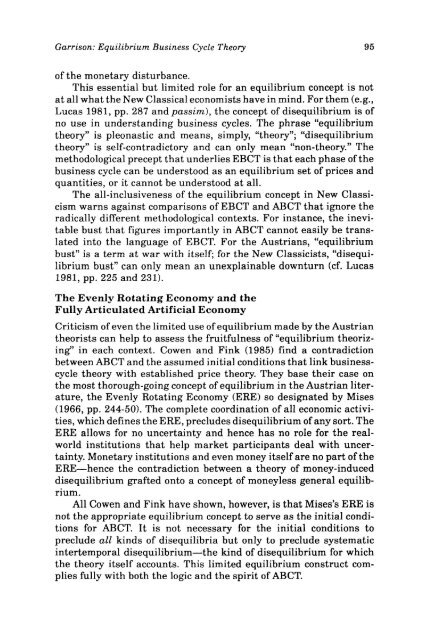Review of Austrian Economics - The Ludwig von Mises Institute
Review of Austrian Economics - The Ludwig von Mises Institute
Review of Austrian Economics - The Ludwig von Mises Institute
Create successful ePaper yourself
Turn your PDF publications into a flip-book with our unique Google optimized e-Paper software.
Garrison: Equilibrium Business Cycle <strong>The</strong>ory 95<br />
<strong>of</strong> the monetary disturbance.<br />
This essential but limited role for an equilibrium concept is not<br />
at all what the New Classical economists have in mind. For them (e.g.,<br />
Lucas 1981, pp. 287 and passim), the concept <strong>of</strong> disequilibrium is <strong>of</strong><br />
no use in understanding business cycles. <strong>The</strong> phrase "equilibrium<br />
theory" is pleonastic and means, simply, "theory"; "disequilibrium<br />
theory" is self-contradictory and can only mean "non-theory." <strong>The</strong><br />
methodological precept that underlies EBCT is that each phase <strong>of</strong> the<br />
business cycle can be understood as an equilibrium set <strong>of</strong> prices and<br />
quantities, or it cannot be understood at all.<br />
<strong>The</strong> all-inclusiveness <strong>of</strong> the equilibrium concept in New Classicism<br />
warns against comparisons <strong>of</strong> EBCT and ABCT that ignore the<br />
radically different methodological contexts. For instance, the inevitable<br />
bust that figures importantly in ABCT cannot easily be translated<br />
into the language <strong>of</strong> EBCT. For the <strong>Austrian</strong>s, "equilibrium<br />
bust" is a term at war with itself; for the New Classicists, "disequilibrium<br />
bust" can only mean an unexplainable downturn (cf. Lucas<br />
1981, pp. 225 and 231).<br />
<strong>The</strong> Evenly Rotating Economy and the<br />
Fully Articulated Artificial Economy<br />
Criticism <strong>of</strong> even the limited use <strong>of</strong> equilibrium made by the <strong>Austrian</strong><br />
theorists can help to assess the fruitfulness <strong>of</strong> "equilibrium theorizing"<br />
in each context. Cowen and Fink (1985) find a contradiction<br />
between ABCT and the assumed initial conditions that link businesscycle<br />
theory with established price theory. <strong>The</strong>y base their case on<br />
the most thorough-going concept <strong>of</strong> equilibrium in the <strong>Austrian</strong> literature,<br />
the Evenly Rotating Economy (ERE) so designated by <strong>Mises</strong><br />
(1966, pp. 244-50). <strong>The</strong> complete coordination <strong>of</strong> all economic activities,<br />
which defines the ERE, precludes disequilibrium <strong>of</strong> any sort. <strong>The</strong><br />
ERE allows for no uncertainty and hence has no role for the realworld<br />
institutions that help market participants deal with uncertainty.<br />
Monetary institutions and even money itself are no part <strong>of</strong> the<br />
ERE—hence the contradiction between a theory <strong>of</strong> money-induced<br />
disequilibrium grafted onto a concept <strong>of</strong> moneyless general equilibrium.<br />
All Cowen and Fink have shown, however, is that <strong>Mises</strong>'s ERE is<br />
not the appropriate equilibrium concept to serve as the initial conditions<br />
for ABCT. It is not necessary for the initial conditions to<br />
preclude all kinds <strong>of</strong> disequilibria but only to preclude systematic<br />
intertemporal disequilibrium—the kind <strong>of</strong> disequilibrium for which<br />
the theory itself accounts. This limited equilibrium construct complies<br />
fully with both the logic and the spirit <strong>of</strong> ABCT.

















